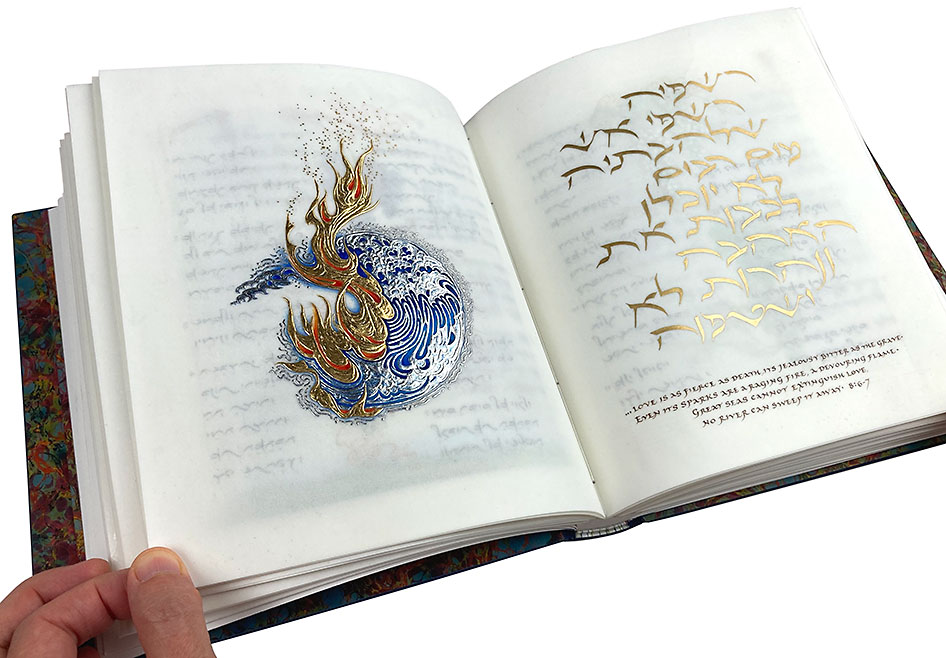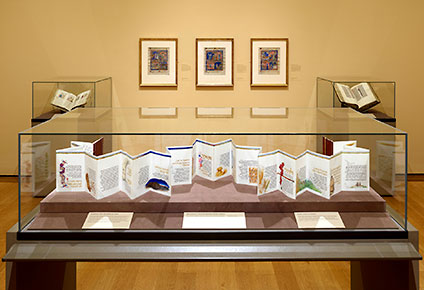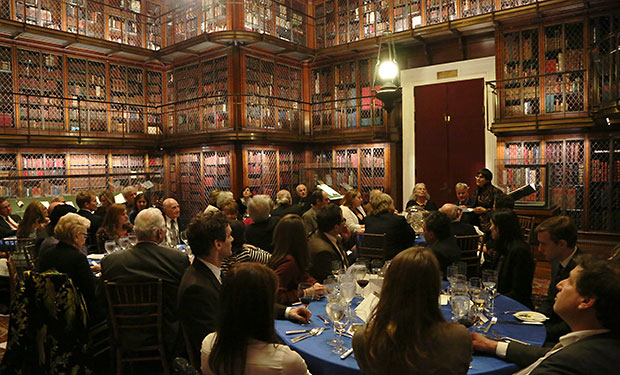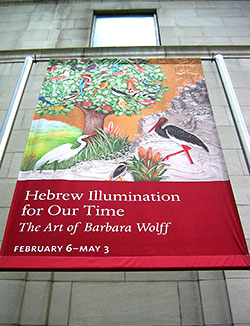Barbara Wolff's A Tent for The Sun is now part of the permanent collection of the Morgan Library & Museum. This lavishly illuminated manuscript celebrates the Hebrew poetry of Convivencia, a golden age of cultural interaction between Muslims, Jews, and Christians in medieval Iberia.
For the first time, Hebrew poets strayed from religious themes and included secular subjects in a style adapted from their Muslim neighbors. The album contains eleven poems, all very much a taste of their age—witty, amusing, and profound.

Be Glad She Said by Shmuel Hanagid, on exhibit at the entrance of the Morgan exhibition


Detail of Be Glad She Said and So It Came To Nothing by Shelomo Ibn Gabriel


Wedding Poem and Where Will I Find You by Yehuda Halevi.
The Song of Songs is the most recent acquisition by the Morgan Library & Museum and has been added to their Judaica collection of contemporary Jewish manuscripts by artist Barbara Wolff.

Song of Songs is unique within the Hebrew bible. In it, there is no mention of God, laws, or Israel's covenant. It does not teach or dispense wisdom. Instead, with the most exquisite poetry, it celebrates romantic love. The voices of its two lovers sing a song beloved by Jews for millennia—lines recited under the wedding canopy and chanted in synagogues during the Passover holiday. The manuscript comprises 52 calf vellum pages. Illuminations are in gold, silver and platinum.
Robert Alter
The 24 accordion-fold manuscript pages of The Book of Ruth by Barbara Wolff has been added to the permanent collection of the Morgan Library & Museum.

The chapters of the Book of Ruth can be considered as four stories, each with its distinct character, visual language, and ethical message. Together they blend into a pastoral narrative set in the springtime ingathering of the grain. While the backdrop to the agricultural setting is a bountiful harvest, the story of Ruth begins with a phrase repeated for thousands of years in many forms: "There was famine in the land." These are words that reflect the precarious climate of the Middle East and the vulnerability of its inhabitants. Famine, preceded by drought, has toppled empires and again and again sent entire populations in search of food.
It is a story told by women speaking directly to one another about life in a world constructed for men. It is a story about wisdom and strength, courage and devotion. It is a study in self-reliance and a willingness to challenge the social order to give voice to the powerless and deprived.
"The Morgan has served as a museum for over 100 years, and this is only the third time it has featured Hebraica. The second instance, in 2015, also featured work by Wolff—an illuminated Passover Haggadah and Psalm 104. ... Wolff's work offers something unique: a combination of medieval artistry, careful scholarship, and the sort of creativity enabled by contemporary technology."
Diane Cole, The Jewish Week, New York

"Hebrew Illumination for Our Time: The Art of Barbara Wolff," first shown in 2015 and now in the Morgan's permanent collection, was their first major exhibition of Jewish manuscript illuminations.
“Barbara Wolff has an ability to work with gold, silver and foil in a manner I've never seen anybody in the modern age command,” he says. ‘It's like being an alchemist,' Wolff says in an interview. 'It's magic turning these pieces into gold. You live a 13th-century timeline in the 21st century.'
“Wolff's drawings are beautifully detailed and executed with precision—it's no surprise to learn that she worked as a botanical and natural science illustrator before turning to this work. In the fullest sense, she illuminates the text, interpreting the words through her art and teasing out new meaning, and, through the shining gold and deep colors, bringing light to the room. She's inventive, often playful—again echoing the medieval artists, who sometimes added small elements of surprise. If you keep looking, you'll find something new.”
—Sandee Brawarsky, Culture Editor, The Jewish Week

Entrance to the exhibition

Photograph by John Calabrese, 2015
Exhibition street banner

Wolff (right) speaking at the formal opening dinner in the Library of John Pierpont Morgan.
